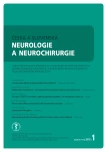Parosmia and phantosmia in patients with olfactory dysfunction
Authors:
P. Brothánková 1,2; J. Vodička 1,2
Authors‘ workplace:
Fakulta zdravotnických studií, Univerzita Pardubice
1; Klinika otorinolaryngologie a chirurgie hlavy a krku, Nemocnice Pardubického kraje, a. s., Pardubická nemocnice
2
Published in:
Cesk Slov Neurol N 2018; 81(1): 51-54
Category:
Original Paper
doi:
https://doi.org/10.14735/amcsnn201851
Overview
Objective:
The aim of the study was to evaluate incidence of parosmia and phantosmia in patients with olfactory dysfunction. We used a specific questionnaire, which is not commonly applied in clinical practice.
Methods:
A total of 115 persons with olfactory dysfunction were included to the study. They were aged between 18 and 83 years (mean age 54 years); 66 women (mean age 57 years ) and 49 men (mean age 51). Olfactory function was evaluated using the Odorized Markers Test and Sniffin‘ Sticks test (identification). The questionnaire was developed and supplemented by specific questions and needs to reflect Czech culture and cogitation. The questionnaire consists of 32 statements, three of which are focused on parosmia and phantosmia.
Results:
Qualitative smell disorders were reported in 51% of respondents. We did not prove any statistically significant influence of gender (p = 0.34) and etiology (p = 0.45) on parosmia and phantosmia. On the contrary, our study showed statistically significant results of olfactory testing. Patients with hyposmia often have more parosmia and phantosmia than those patients with olfactory loss (p < 0.01). Patients with long-term smell dysfunction suffered more frequently from parosmia (p < 0.01).
Conclusion:
When taking clinical history, it is essential to ask the patient about any qualitative disorders (parosmia, phantosmia) and questionnaires should be systematically administered to patients referred with olfactory complaints.
Key words:
parosmia – phantosmia – dysosmia – olfaction – quality of life
The authors declare they have no potential conflicts of interest concerning drugs, products, or services used in the study.
The Editorial Board declares that the manuscript met the ICMJE “uniform requirements” for biomedical papers.
Chinese summary - 摘要
嗅觉功能障碍患者的嗅觉异常和嗅觉缺失目的:
本研究的目的是评估嗅觉功能障碍患者的嗅觉异常和嗅觉缺失的发生率。 我们使用了一个特殊的问卷,这在临床实践中并不常用。
方法:
本研究共纳入115名嗅觉功能障碍患者。 他们年龄介于18至83岁(平均年龄54岁); 66名女性(平均年龄57岁)和49名男性(平均年龄51岁)。 使用气味标志物测试和嗅觉棒测试(鉴定)评估嗅觉功能。 问卷通过具体问题制定和补充,同时需要反映捷克文化和思想。调查问卷包含32份陈述,其中三份重点关注嗅觉异常和嗅觉缺失。结果:
51%的受访者报告定性气味障碍。 我们没有发现性别(p = 0.34)和病因学(p = 0.45)对嗅觉异常和嗅觉缺失有显著地统计学的影响。 相反,我们的研究显示嗅觉测试的统计学显著结果。与嗅觉丧失患者相比,嗅觉障碍患者常有更多的嗅觉异常和嗅觉缺失(p <0.01)。 患有长期嗅觉障碍的患者经常感觉嗅觉异常(p <0.01)。
结论:
在询问临床病史时,必须向患者询问有关任何定性疾病(嗅觉异常和嗅觉缺失),问卷应系统地用于嗅觉异常的患者。
关键词:
嗅觉异常-嗅觉缺失-嗅觉障碍 - 嗅觉 - 生活质量
Sources
1. Vaňásková E, Bednář M. Hodnocení parametrů kvality života u vybraných neurologických onemocnění. Neurol praxi 2013; 14(3): 133–135.
2. Lötsch L, Ultsch A, Eckhardt M et al. Brain lesion-pattern analysis in patients with olfactory dysfunctions following head trauma. Neuroimage Clin 2016; 11: 99–105. doi: 10.1016/ j.nicl.2016.01.011.
3. Martinec Nováková L, Štěpánková H, Vodička J et al. Přínos vyšetření čichu pro diagnostiku neurodegenerativních onemocnění. Cesk Slov Neurol N 2015; 78/ 111(5): 517–525.
4. Frasnelli J, Hummel T. Olfactory dysfunction and daily life. Eur Arch Otorhinolaryngol 2005; 262(3): 231–235. doi: 10.1007/ s00405-004-0796-y.
5. Vodička J, Faitlová H. Poruchy čichu a chuti. 1. vyd. Havlíčkův Brod: Tobiáš, 2012.
6. Yang DH, Wang J, Daefeng N et al. Reliability and validity of the Chinese version of the questionnaire of olfactory disorders (QOD) when used with patients having olfactory dysfunction. Eur Arch Otorhinolaryngol 2016; 273(10): 3255–3261. doi: 10.1007/ s00405-015-3869-1.
7. Brothánková P, Nedomová E, Vodička J. Kvalita života osob s poruchou čichu. Ošetrovateľstvo a pôrodná asistencia 2017; 55(2): 51–55.
8. Vodička J, Menšíková A, Balatková Z et al. Fyziologické hodnoty čichových testů v české populaci. Otorinolaryng a foniat 2011; 60(3): 119–124.
9. Simopoulos E, Katotomichelakis M, Gouveris H et al. Olfaction-associated quality of life in chronic rhinosinusitis: adaptation and validation of an olfaction-specific questionnaire. Laryngoscope 2012; 122(7): 1450–1454. doi: 10.1002/ lary.23349.
10. Fonteyn S, Huart C, Deggouj N et al. Non-sinonasal-related olfactory dysfunction: a cohort of 496 patients. Eur Ann Otorhinolaryngol Head Neck Dis 2014; 131(2): 87–91. doi: 10.1016/ j.anorl.2013.03.006.
11. Hummel T, Landis BN, Hüttenbrink KB. Smell and taste disorders. GMS Curr Top Otorhinolaryngol Head Neck Surg 2011; 10(4): 1–15. doi: 10.3205/ cto000077.
12. Croy I, Yarina S, Hummel T. Enhanced parosmia and phantosmia in patients with severe depression. Psychol Med 2013; 43(11): 2460–2464. doi: 10.1017/ S0033291713001773.
13. Hummel T, Lotsch J. Prognostic factors of olfactory dysfunction. Arch Otolaryngol Head Neck Surg 2010; 136(4): 347–351. doi: 10.1001/ archoto.2010.27.
Labels
Paediatric neurology Neurosurgery NeurologyArticle was published in
Czech and Slovak Neurology and Neurosurgery

2018 Issue 1
Most read in this issue
- A neurological view on spondylodiscitis
- Parosmia and phantosmia in patients with olfactory dysfunction
- Assessment of cognitive functions using short repeatable neuropsychological batteries
- Cavernous sinus thrombosis – still occurring complication of rhinosinusitis
